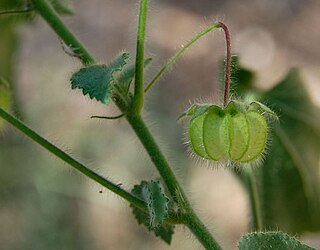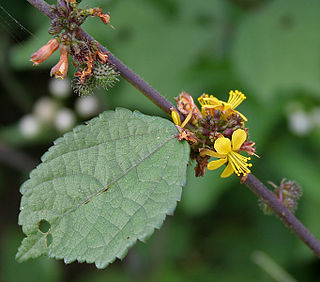
Abutilon is a large genus of flowering plants in the mallow family, Malvaceae. It is distributed throughout the tropics and subtropics of the Americas, Africa, Asia, and Australia. General common names include Indian mallow and velvetleaf; ornamental varieties may be known as room maple, parlor maple, or flowering maple. The genus name is an 18th-century Neo-Latin word that came from the Arabic ’abū-ṭīlūn, the name given by Avicenna to this or a similar genus.

Vismia is a genus of flowering plants in the family Hypericaceae. Members of the genus are small trees and shrubs found in tropical and subtropical areas of Central America and South America. Including the countries of Belize, Bolivia, Brazil, Colombia, Costa Rica, Ecuador, El Salvador, French Guiana, Guatemala, Guyana, Honduras, Mexico, Nicaragua, Panamá, Peru, Suriname, Trinidad-Tobago and Venezuela.

Erythroxylum (Erythroxylon) is a genus of tropical flowering plants in the family Erythroxylaceae. Many of the approximately 200 species contain the substance cocaine, and two of the species within this genus, Erythroxylum coca and Erythroxylum novogranatense, both native to South America, are the main commercial source of cocaine and of the mild stimulant coca tea. Another species, Erythroxylum vaccinifolium is used as an aphrodisiac in Brazilian drinks and herbal medicine.

Cleome is a genus of flowering plants in the family Cleomaceae, commonly known as spider flowers, spider plants, spider weeds, or bee plants. Previously, it had been placed in the family Capparaceae, until DNA studies found the Cleomaceae genera to be more closely related to the Brassicaceae than the Capparaceae. Cleome and clammyweed can sometimes be confused. The simplest way to differentiate the two is to compare the seedpods which project out or down on cleome and up on clammyweed.

Herissantia is a small genus of flowering plants in the mallow family sometimes referred to as bladder mallows. These are five species of annual and perennial herbs with trailing stems and bladderlike fruits. They are native to the tropical and warm temperate Americas. The most widely distributed species is Herissantia crispa, which can be found on other continents as an introduced species.

Hibisceae is a tribe of flowering plants in the mallow family Malvaceae, subfamily Malvoideae.

Triumfetta is a genus of plants in the family Malvaceae. Burbark is a common name for plants in this genus.
Allosidastrum is a New World genus comprising four species in the tribe Malveae in the family Malvaceae. Members of the genus are woody, bearing ovate leaves with long petioles. Flowers - borne without calyculi - bear small, basally rounded calyxes of a length greater than that of their pedicels and whitish or palely yellow petals. Gynoeciums each consist of five to nine carpels and mature into fruits that yield one seed for each of their carpels.

Fuertesimalva is a genus of flowering plants in the mallow family Malvaceae, native to Mexico, Venezuela, Colombia, Ecuador, Bolivia, Peru and Argentina. Most species in this genus were originally placed in Urocarpidium.
Bakeridesia is a genus of flowering plants belonging to the family Malvaceae.
Briquetia is a genus of flowering plants belonging to the family Malvaceae.
Hochreutinera is a genus of flowering plants belonging to the family Malvaceae.

Malvastrum is a genus of flowering plants belonging to the family Malvaceae.
Peltaea is a genus of flowering plants belonging to the family Malvaceae.
Sidastrum is a genus of flowering plants belonging to the family Malvaceae.

Gaya is a genus of flowering plants belonging to the family Malvaceae. It has been classed in the Malvoideae subfamily and the Malveae tribe.










